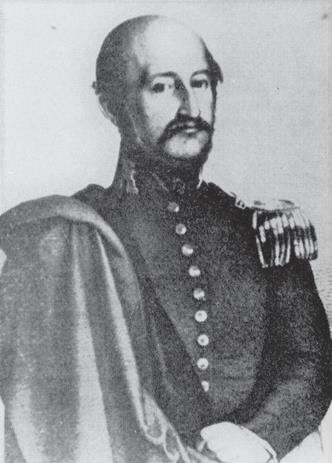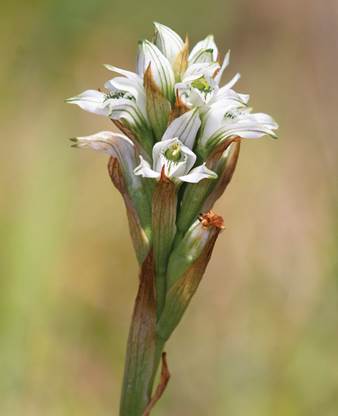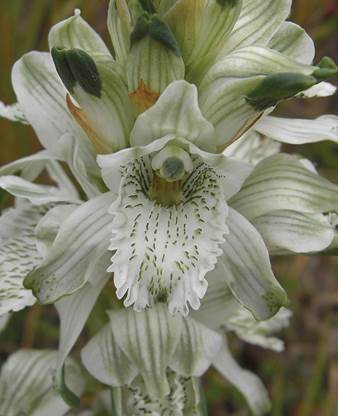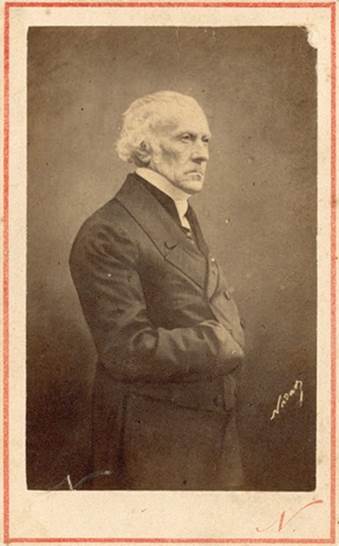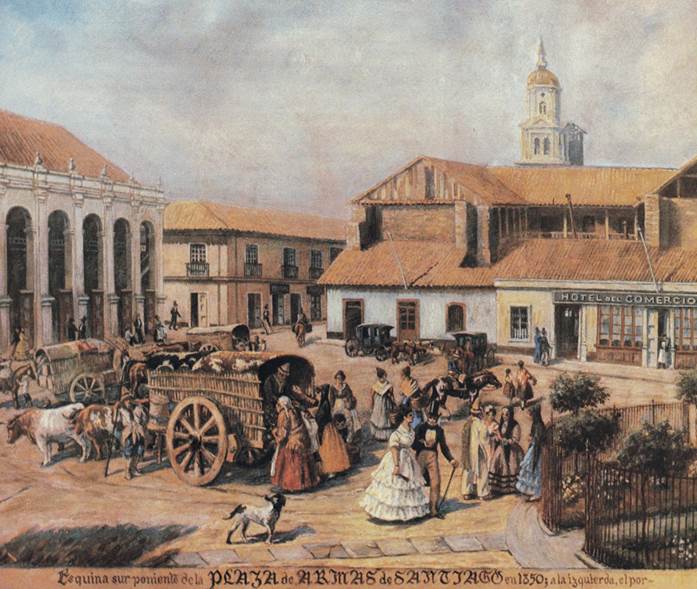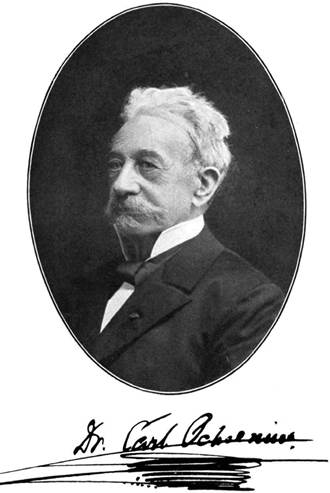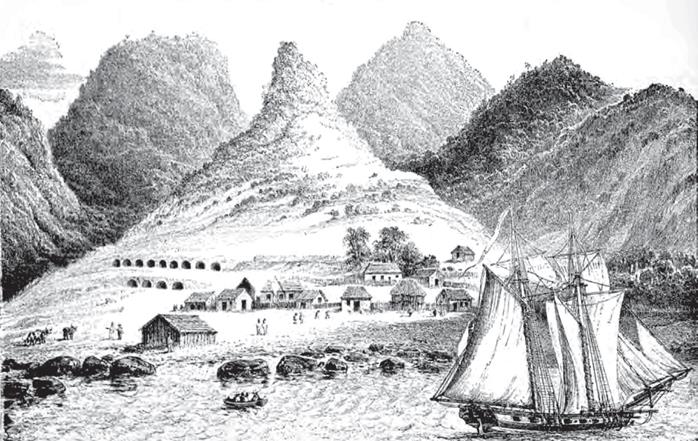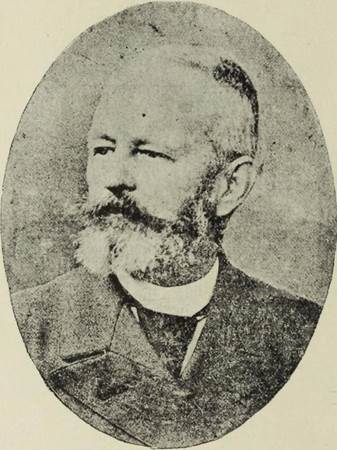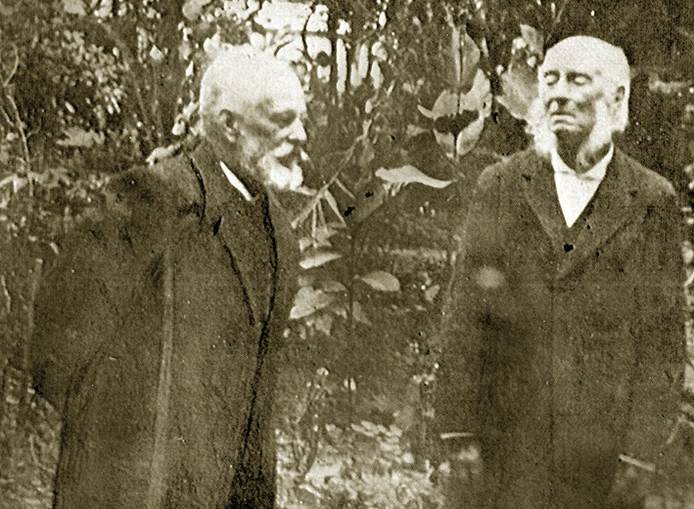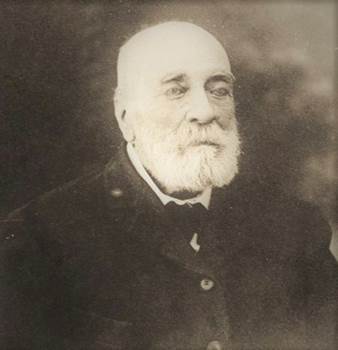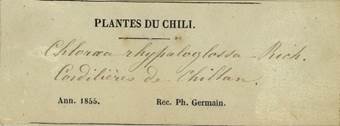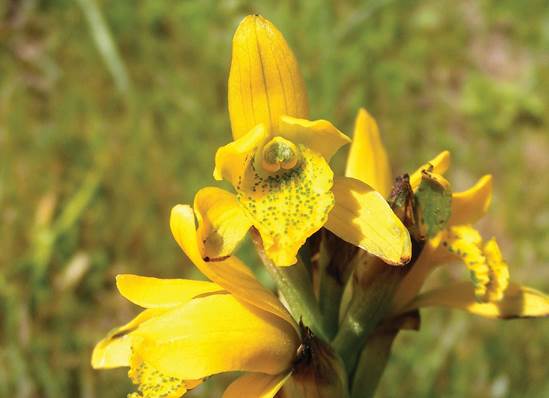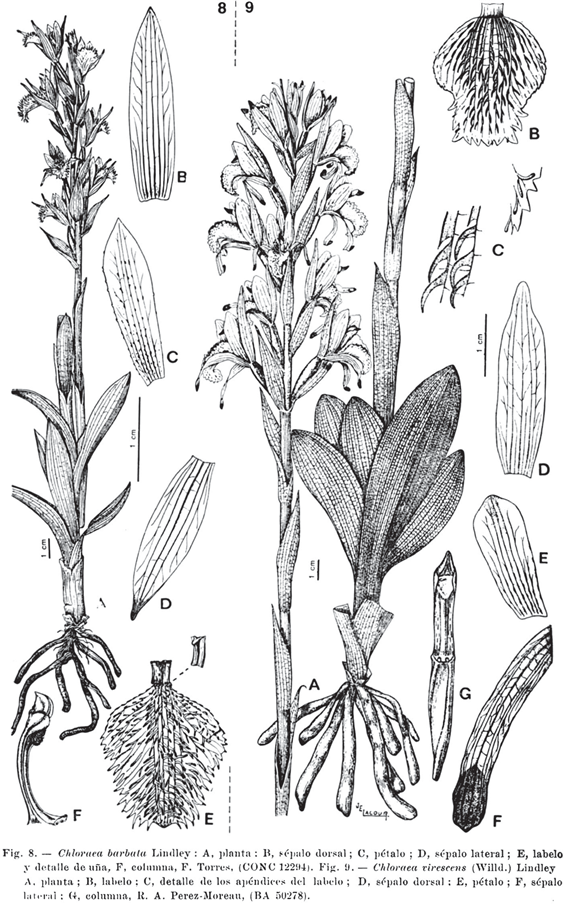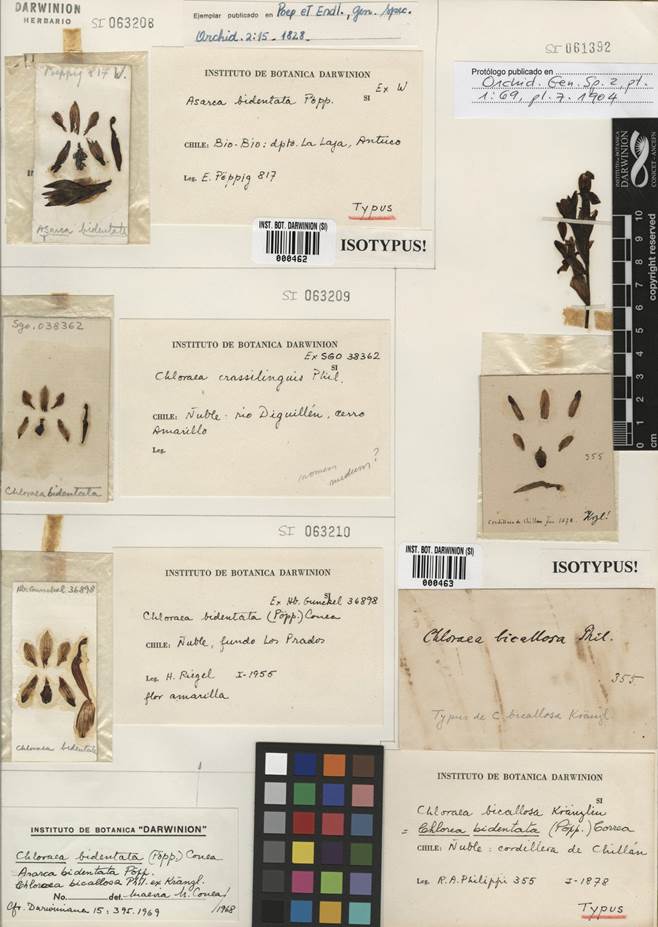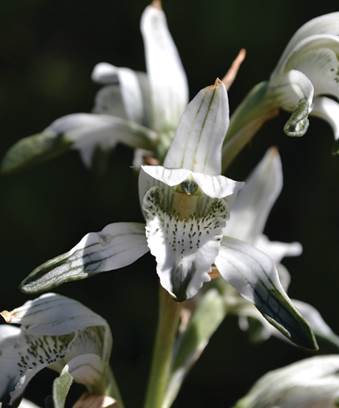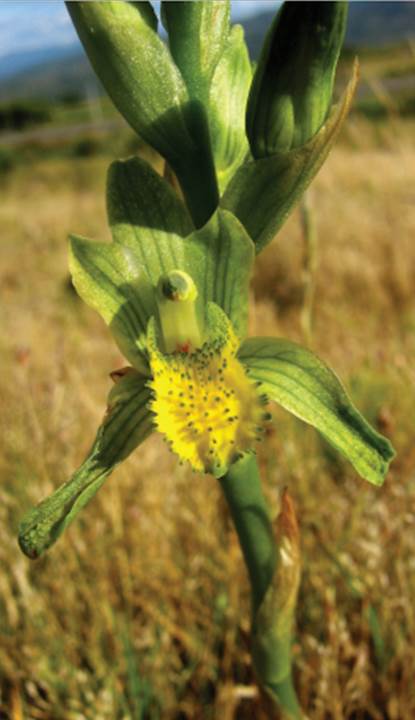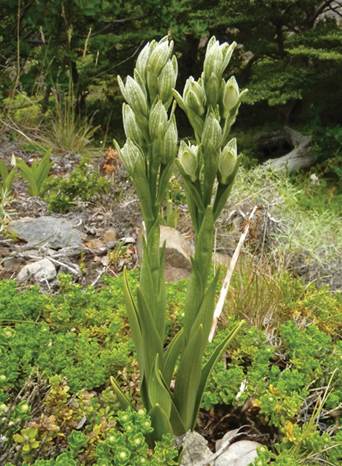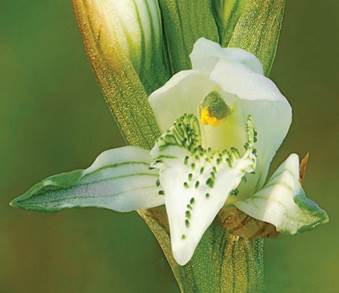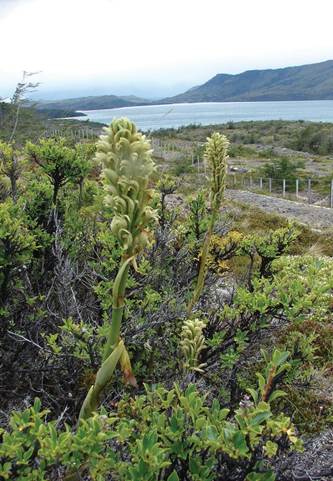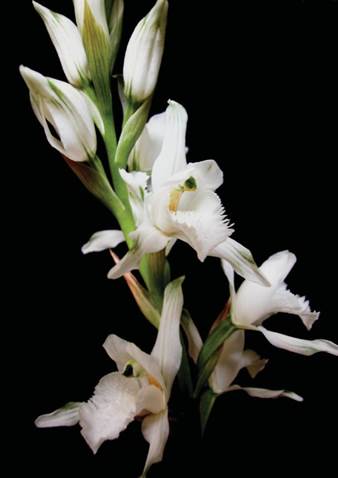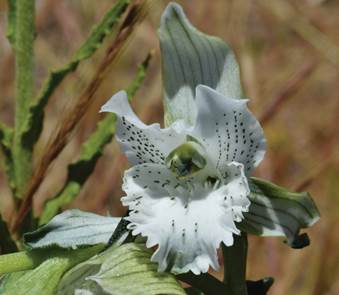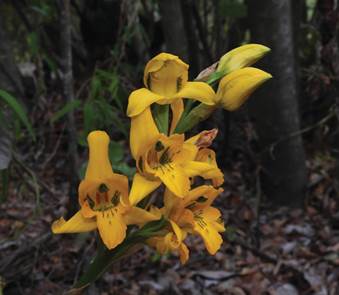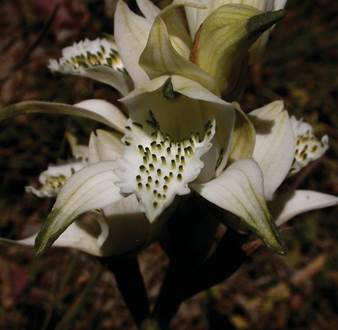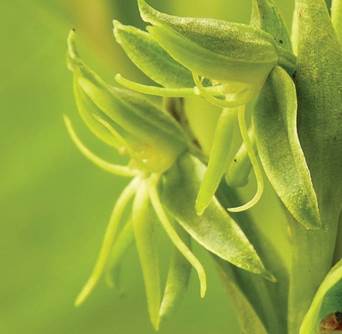Bernhard Eunom Philippi (1811-1852) (Fig. 1) was born in Berlin and as a young boy, moved with his family to Switzerland in 1818. Together with his brother Rudolph, he attended the school of Heinrich Pestalozzi in Yverdon, where he studied natural sciences and languages. However, more inclined toward the exact sciences, he completed his studies at the School of Engineering in Berlin between 1822 and 1830. After learning the arts of navigation and seamanship in the harbor of Danzig, Philippi took part in two expeditions to Chile and Peru, between 1831 and 1837. In 1840, he was appointed as a traveling naturalist by the Zoological Museum in Berlin and established himself in the village of Ancud, on the Chilean island of Chiloé. In Ancud, he made the acquaintance of Captain John Williams, who in 1843, encouraged him to take part in the Chilean expedition that would take possession of the Strait of Magellan. The schooner Ancud was built especially for this expedition. After securing the Strait of Magellan for Chile (just one day before the arrival of the French warship Le Phaèton, which sailed with similar intentions), Philippi played an important role in designing the fortifications that were built on the site of the future city of Punta Arenas (founded in 1848) (Fig. 2).
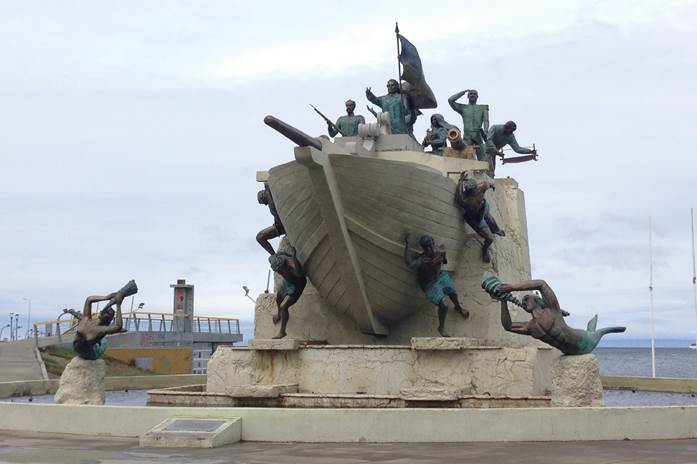
Unknown photographer.
Figure 2 Monument to the sailors of the schooner Ancud, in Punta Arenas, Chile.
In 1848, Bernhard Philippi traveled to Germany with orders of the Chilean President Bulnes to recruit German settlers, a mission he completed successfully. Soon, the first German colonies began to flourish in Valdivia. In 1852, he was called back by the Chilean authorities and was appointed Governor of the province of Magallanes. Only a few months later, he disappeared during an excursion, presumably killed in an attack by the natives.
During his 1838 journey to Chile, Philippi had made the acquaintance of a collector of specimens of natural history, the German by the name of Carlos Segeth (1811-1890), who interested Philippi in forming a society to sell botanical and zoological collections in Europe. The society was short-lived, but a few botanical specimens were received by Heinrich Gustav Reichenbach (1823-1889), Germany’s famous orchidologist of the 19th century, who, amongst Bernhard Philippi’s collections, described four new orchid species: Chloraea philippii Rchb.f. (Fig. 3), C. heteroglossa Rchb.f. (Fig. 4), C. unguis-cati Rchb.f., and Epidendrum philippii Rchb.f. There is no possible confusion as to which of the brothers collected these orchids because they were described in 1849-1850, while Rudolph Philippi did not arrive in Chile until 1851. Furthermore, E. philippii is a native of Peru, where Rudolph Philippi, never collected.
Rudolph Amandus and Federico Philippi
“The second half of the nineteenth century was dominated by the work of Rudolf Amandus Philippi (1808-1904) (Fig. 5), in Chile from 1851 to 1897; he was effectively responsible, along with his son and successor Federico, for the establishment of the present national herbarium in Santiago” (Frodin 2001).
In 1858, Rudolph Philippi wrote to Guillermo Frick (1818-1905), a German friend in Valdivia, to recount a humorous comment that someone else had made about Philippi’s dedication to natural history: “What is it that Philippi does? He hunts flies, and then he observes them through a large lens and captures them in a drawing. It’s surprising the way in which some men can earn their bread” (Translated from German into English by Schell 2013).
Rudolph Amandus Philippi (1808-1904) was born just outside Berlin and studied, together with his brother Bernhard, natural history at Pestalozzi’s institution in Switzerland. Until his last days, he spoke with great enthusiasm of his years in Yverdon. Later, he obtained a medical degree in Berlin, but never practiced, completely dedicating himself to the natural sciences (Fürstenberg 1905). As a young man, Rudolph traveled widely in Europe, mostly in Italy, where Federico (1836-1910), his first son, was born on the last day of his father’s stay in Naples. After returning to Germany, Rudolph obtained a position as a professor at the Polytechnic School of Kassel, where he would spend 16 years. During this time, Philippi published numerous articles on the paleontology and geology of southern Italy and became widely known in Germany’s scientific community. Political upheaval forced him to leave Kassel precipitously. His long conversations with Bernhard, who at that time was in Germany, the attraction of his brother’s description of the Chilean wildlife, the political unrest in the Duchy of Hesse and his liberal convictions were the determining factors in Rudolph Amandus Philippi’s decision to emigrate to Chile (Chaparral 2010).
After arriving in Valparaiso in late 1851, Rudolph went for a few weeks to Santiago (Fig. 6), where he was introduced to the President of the Republic and then, sailed south to the recently founded German colony of Valdivia. He made his first exploring expeditions inland and shortly after that, together with his brother, acquired the Fundo (“Estate”), San Juan, on Rio Bueno (Fig. 7).
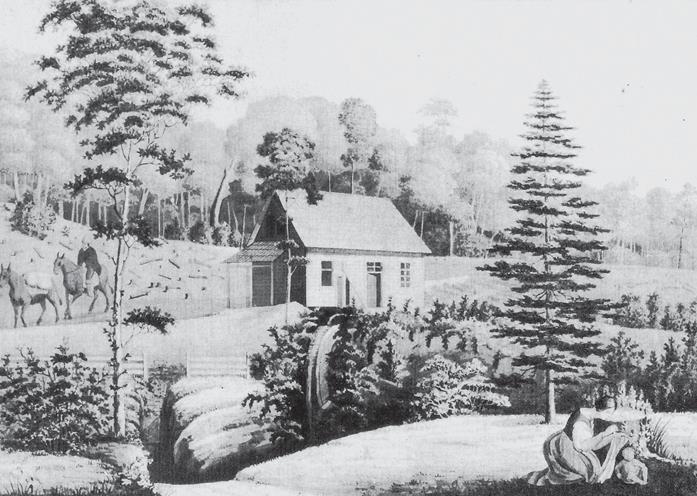
In Phillipi Izquierdo, 1973: plate 97.
Figure 7 Watermill at the Fundo San Juan. By R.A. Philippi, 1856.
Carl Christian Ochsenius (1830-1906) (Fig. 8), a German geology student of Philippi at the Polytechnic School in Kassel, accepted Philippi’s invitation and joined him in his decision to emigrate to Chile. Ochsenius spent the following twenty years in Chile and became Rudolf Philippi’s lifelong friend. He accompanied Philippi on many of his excursions and took over the administration of the “Fundo” San Juan from 1853 to 1856 after Philippi moved to Santiago following his appointment as university professor. In 1884, he published a book about his experiences in Chile, Chile Land und Leute (‘Chile, the land and its people’), with a few illustrations by himself (Fig. 9). In 1906, shortly before his death, Ochsenius published what is probably known as the best biography of Rudolph Philippi (Ochsenius 1906). He made important contributions to Chile’s copper and saltpeter industries during his time in Chile. In 1871, Ochsenius left Chile and returned to his native Marburg, where he spent the rest of his life as professor at the local university.
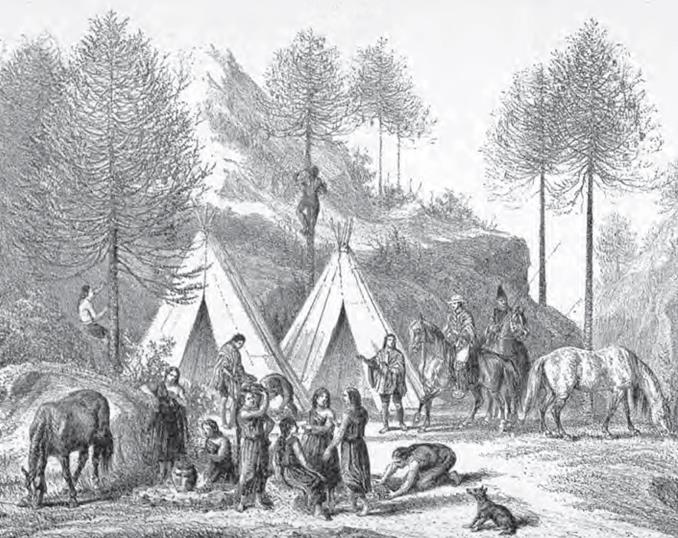
Drawing by C. Ochsenius in Chile, Land und Leute (Ochsenius 1884: Figure 12).
Figure 9 Collecting Araucaria cones.
After his brother’s death, Rudolph Philippi became the sole proprietor of the San Juan estate. However, he maintained his scientific activities and, besides numerous excursions in the province of Valdivia, had the opportunity to climb the Osorno volcano. Philippi’s reports to the university in Santiago awoke the interest of the government and he was named as first director of the high school in Valdivia, and then, in 1853, professor of natural sciences at the University of Chile and director of the Natural History Museum. The Museum had been housed in the (new) building of the University since 1863. In 1876, it was moved into a new building on the lands of the School of Agriculture (Fig. 10-11).
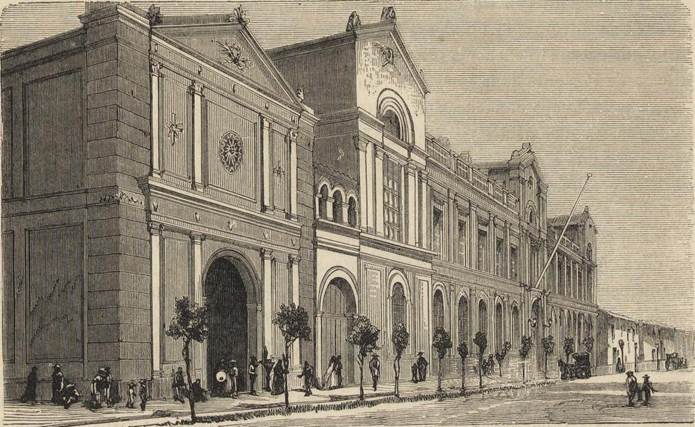
Unknown author.
Figure 10 Main building of the University of Chile, home to the Natural History Museum from 1863 to 1876.
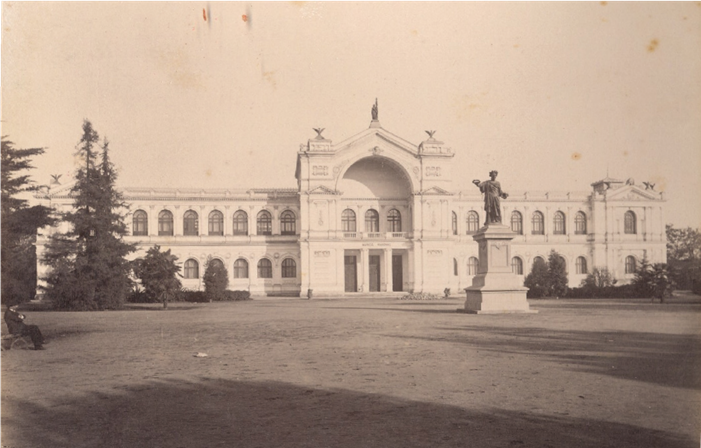
Unknown photographer.
Figure 11 The new building of the Natural History Museum of Chile, inaugurated in 1876 on lands of the School of Agriculture in Santiago, the so-called “Quinta Normal de Agricultura”.
Rudolph Philippi served as professor of natural sciences until 1874, as director of the Botanical Garden until 1883, and continued as director of the Natural History Museum, until 1897. His successor at the Garden and the Museum was his son Federico, who was active until his death, in 1910.
Many of Philippi’s herbarium specimens were distributed in Europe through Rudolf Friedrich Hohenacker (1798-1874), a member of the “Unio Itineraria” (in German “Botanischer Reiseverein”), a joint-stock company founded in 1827 exclusively responsible for sending botanists on travels to collect herbarium specimens. Thus, many of Philippi’s specimens presently found at the Natural History Museum in Paris were labeled as R. A. Philippi pl. chilens. Ed. R. F. Hohenacker (Fig. 12).
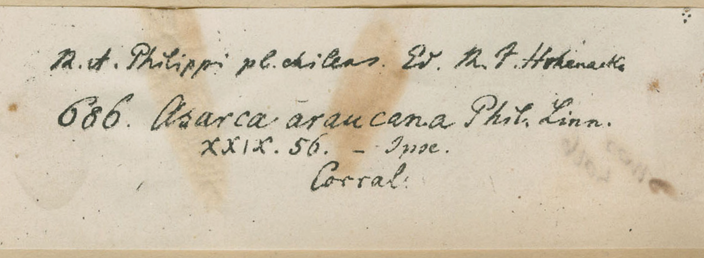
Figure 12 Herbarium label of Asarca araucana Phil. in the collection of R. F. Hohenacker. MNHN Paris.
During his 44 years of service, Philippi maintained his collecting activities in the field, and as an untiring publisher of scientific articles in all fields of the natural sciences he wrote over 300 articles about zoology, botany, geology, paleontology, mineralogy, geography, and ethnography. “Among his scientific endeavors, he contributed taxonomic descriptions to the biological diversity of Chile, encompassing organisms in three living kingdoms: plants, animals and fungi. We have examined his contribution to the knowledge of the biological wealth of Chile, quantifying the number and proportion of current valid species he described. Our findings indicate that Philippi described 1670 valid species, equivalent to 5.8% of the recognized biological diversity of Chile. His greatest contributions were in vascular plants with 1017 species descriptions, which represent 19% of the vascular flora of Chile.” (Castro et al. 2006). As to his botanical excursions, those to the desert of Atacama and the islands of Juan Fernández stand out. During his scientific excursions, Rudolph Philippi prepared several highly interesting pencil drawings depicting the Chilean scenery and the life of its inhabitants (Fig. 13-14), later published by his grandson, Federico’s son, Julio Philippi Izquierdo (1912-1997), as Vistas de Chile (‘Views from Chile’) (Philippi Izquierdo 1973). “However, some of those drawings were not Philippi’s originals, but were copied from drawings made by Alexander Simon (1805-1852), a German artist who spent the last few years of his life in Chile with Bernhard Philippi before dying in unknown circumstances in Patagonia” (Kabat & Coan 2017).
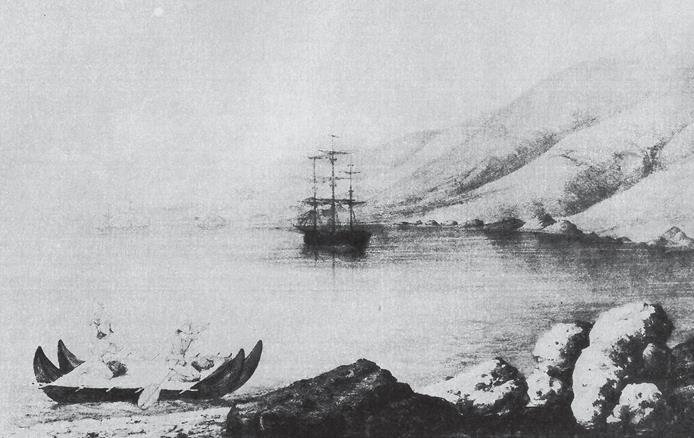
By R. A. Philippi. In Phillipi Izquierdo, 1973: plate 34.
Figure 13 Harbor of El Cobre, province of Antofagasta, Philippi’s arrival port on his expedition to the desert of Atacama.
Philippi's contribution to Chile’s national science can be summarized as follows: “his collecting expeditions in most of its territory; his theoretical contribution to the realm of superior education as a professor at the National Institute and later at the University of Chile; his work as director of the Natural History Museum and the Botanical Garden in Santiago; and his large collections of objects in all aspects of the country’s natural history, which complemented those initiated by Claude Gay in 1830” (Saldivia 2015). Rudolph Philippi’s last recorded collecting excursion took him in March 1896 to the city of Constitución, province of Maule, in Central Chile. At the time he was already 88 years of age.
Friedrich (Federico) Heinrich Eunom Philippi (1836-1910) (Fig. 15-16) began his studies of natural history in Kassel, during his father’s direction of the natural history department of the local university. After Rudolph Philippi’s appointment as director of the Natural History Museum and the Botanical Garden in Santiago, Federico and the rest of the family followed him to Chile, where they arrived in late 1853. They brought with them Rudolph’s private library, an invaluable treasure for Chile's scientific world.
Federico, a 17-year-old boy by then, worked at the family estate in Valdivia where he began collecting plants for his herbarium. From 1860 he accompanied his father on his botanical excursions. He was responsible for most of the collections, but it was his father who described most of the new species.
Federico Philippi returned to Germany and studied botany and zoology, from 1871 to 1874, at the University of Halle. After returning to Chile, he became the successor of his father as a professor of botany in Santiago and later as director of the Natural History Museum and the Botanical Garden. Until 1897, he also taught zoology at the Institute for Agriculture, and botany at the Faculty of Medicine, until 1906.
The earthquake of August 1906 inflicted serious damage on the building of the Museum, and Federico, putting his life at risk, worked for days rescuing what was left of the collections, now buried under the rubble. Nevertheless, the Museum was his passion, and his work there was interrupted only by his death, in 1910.
The most important legacy of Federico Philippi was the continuation of Claude Gay’s and his father’s work, increasing and organizing the botanical and zoological collections of the Museum, which, at the turn of the century, made him the main scientific authority in Chile.
When Federico took over from his father as director of the Natural History Museum in 1897, he was already 61 years old. The longevity of Rudolph Philippi and his imposing authority as Chile’s most important scientist in the second half of the 19th century made it inevitable that Federico lived for most of his life under the shadow of his father. In a photograph of father and son, taken in 1902, it is somewhat difficult to distinguish one from the other (Fig. 16).
An important contribution of Federico Philippi was the publication, in 1881, of his Catalogus plantarum vascularium Chilensium. In this treatise, he enumerated a total of 86 (!) orchid species, a list that is undoubtedly full of synonyms since the total in F. Philippi’s Catalogus exceeds by far the present number of accepted Chilean species of orchids. Federico described a total of 33 new species in different plant families, a relatively small number when compared to that of his father.
Today, the types of species described by the Philippis are housed in a separate collection at the Natural History Museum. This was established by Carlos Muñoz-Pizarro (1913-1976), when the specimens in the herbarium were mounted, a process that began in 1942 and continues today (Taylor & Muñoz-Schick 1994).
The South American orchids of the Philippi dynasty
When we talk about the Philippis’ Chilean orchids, we refer initially to the four species collected by Bernhard and described by Reichenbach (1849) (of which Epidendrum philippii was collected in Peru), and of those new species collected either by Rudolph or by Federico, but described solely by Rudolph Philippi in Linnaea, between 1856 and 1864, and in the Anales de la Universidad de Chile between 1861 and 1865 (Philippi 1856a, b, c, 1857-58a, b, c, 1859, 1861, 1864, 1865). In addition, Friedrich Kraenzlin (1847-1834) described twelve new species collected by the Philippis in his Orchidacearum Genera et Species in 1904.
Table 1 contains a list of South American orchids, described by Reichenbach and Rudolph Philippi. Reichenbach’s descriptions were already mentioned. Philippi mentioned 46 different species in 3 genera, as follows: Asarca Lindl. (6 spp.), Chloraea Lindl. (36 spp.), Habenaria Willd. (3 spp.), and Macrocentrum Hook.f. (1 sp.). For currently accepted names of all Chilean orchids, the author, under the recommendation of reputed taxonomists, relied with few exceptions on the account of the Chilean orchids that Novoa prepared for the recent catalog of vascular plants of Chile by Rodríguez et al. (2018). Other reference works on the same subject are indicated in the literature section of this article, such as Novoa et al. (2006, 2015), Correa (1956, 1969a,b), Zuloaga et al. (2008), Batista et al. (2011) and the TROPICOS database (www.tropicos.org).
Rudolph Philippi also collected and described a new orchid genus from Argentina, Macrocentrum, with the type species M. mendocinum (Philippi 1865). (Fig. 17).
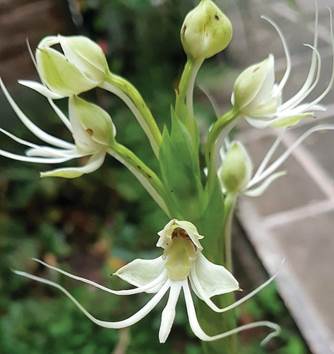
Photograph by Asociación Tucumana de Orquicultores.
Figure 17 Macrocentrum mendocinum Phil. as Habenaria gourlieana Gilles ex Lindl.
Philippi never left South America, but he was never isolated from the broader scientific community. In addition to continuing to publish in German serials (Linnaea, 1856-1859) and founding the Anales del Museo Nacional (1892-1910), which later continued as Boletín del Museo Nacional de Historia Natural, Philippi was visited by many European scientists traveling through Chile.
The Swiss naturalist Johann Jakob von Tschudi (1818-1889), who spent much of his life exploring South America, visited Philippi at the Museo in Santiago, in 1859, and particularly praised Philippi for his work: “I say that this is the most important and bestordered natural history collection in South America, compared with the other institutions I had visited in Brazil, Montevideo and Buenos Aires” (Tschudi 1869). When the Comisión Científica del Pacífico, the 1862-1866 Spanish scientific expedition that collected over 82,000 specimens in South America, landed at Valparaiso in 1863, the naturalists led by anthropologist Marco Jiménez de la Espada (1831-1898) and botanist José Isern Battló (1821-1866) made their way inland to Santiago. “Philippi introduced them to a number of other naturalists and collectors, and the naturalists admired Philippi’s exhibits in the museum and the museum’s fine library” (Kabat & Coan 2017).
Isern wrote in his diary about his encounter with Dr. Rudolph Philippi with words of gratitude for an important number of herbarium specimens donated by Philippi to the expedition, which are housed today at the herbarium of the Royal Botanical Garden in Madrid (Blanco et al. 2006). Among them were specimens of four new orchid species described by Rudolf Philippi: Asarca araucana, Chloraea fimbriata, Chloraea littoralis and Habenaria germainii (Blanco & Puig-Samper 1995). In October 1864, when the Spanish Expedition departed from Chile, Philippi presented them with a letter in which he expressed his best wishes for the rest of the journey, also including a photograph of himself (Fig. 18).
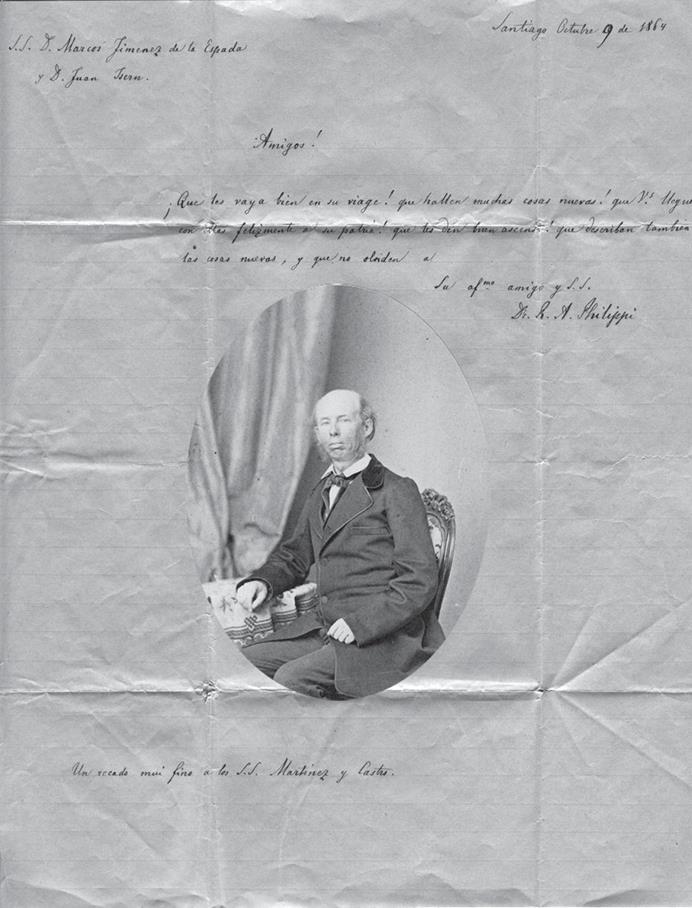
Courtesy of the Royal Botanical Garden, Madrid, and the Spanish Consejo Superior de Investigaciones Científicas.
Figure 18 Letter and photograph from R.A. Philippi to Marcos Jiménez and Juan Isern. 9 October 1864.
Philippi’s Chilean botanical type material is primarily located in the herbarium of the Museo Nacional de Historia Natural in Santiago. Although Claudio Gay (1800-1873) previously described a number of Chilean plants, Gay’s locality information and descriptions left much to be desired, so Philippi’s contributions did much to establish the foundation for systematic botany in Chile. “At the same time, however, Philippi’s uncritical approach to describing new plant species was criticized by subsequent botanists (…) Chilean botanists were nevertheless grateful that Philippi’s material remained in Chile for their study, in contrast to other European botanists whose Chilean specimens are a continent away” (Kabat & Coan 2017).
Philibert Germain (1827-1913) (Fig. 19-20) was a French entomologist born in Lyon, who arrived in Chile in 1850 and occupied the position of professor of natural history and interim curator, after Claude Gay at the Museo Nacional in Santiago. In 1853, after the appointment of Rudolph Amandus Phillipi as director of the Museum and Germain’s demotion to the post of subdirector, Germain resigned from his position because of his cut in salary. Nevertheless, Germain, a Coleoptera specialist, continued to work for the museum as a collector and entomologist until 1910. He spent much of his time traveling and exploring other countries selling entomological and ornithological specimens, but also some plant specimens from Chile, Brazil and Bolivia. After a short interlude from 1889 to 1893 during which he accepted a teaching position at a secondary school in Quillota, Germain returned to the Natural History Museum.
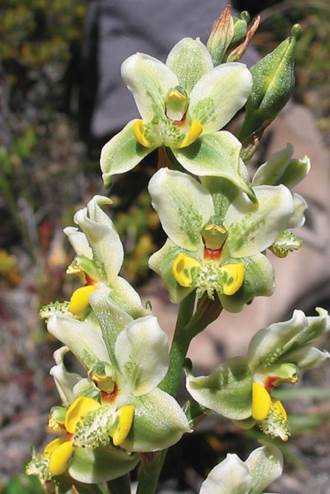
Photograph by Marcela Andina.
Figure 21 Asarca appendiculata Phil. ex. Kraenzl. as Gavilea glandulifera (Poepp) M.N.Correa.
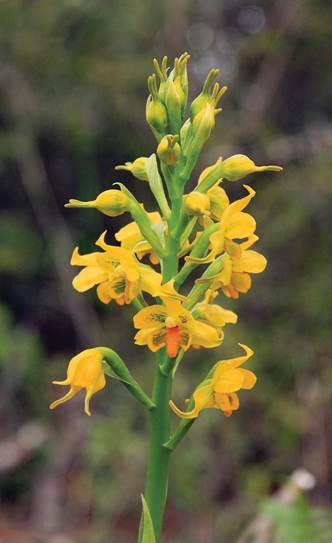
Photograph by Hernán Tolosa.
Figure 22 Asarca chrysostachya Phil. or A. sulphurea Phil. as Gavilea odoratissima Poepp.
During his years in Chile, Germain maintained close relations with Philippi and contributed ten orchid specimens to the flora of Chile (Table 1). One of them, Habenaria germainii, was named by Philippi in his honor. Germain collected mainly in Central Chile, in the Andean departments of Chillán and Linares (Fig. 20).
Table 1: The Philippis’ South American Orchids
| Orchids from Peru | |||
| Basionym | Original collector (date) | Currently accepted name By Rodríguez et al. (2018) | Notes |
| Epydemdrum L | Type: Epidendrum nocturnum Jacq. (1760), Antilles | Epydemdrum L | |
| E. philippii Rchb.f. | B.E. Philippi (ca. 1837) | E. philippii Rchb.f. | *(1) |
| Orchids from Chile | |||
| Asarca Lindl. | Type: Asarca speciosa Lindl. = Chloraea pavonii Pavón (1782-1783), Chile | Gavilea Poepp. | |
| A. appendiculata Phil. ex Kraenzl. | R. and/or F. Philippi (?) | G. glandulifera(Poepp.) M.N.Correa | *(I) (Fig. 21) |
| A. brachychila Phil. | Manuel Antonio de Solís Obando (ca. 1858) | G. lutea(Comm. ex Pers.) M.N.Correa | *(I) |
| A. chrysostachya Phil. | R.A. Philippi (ca. 1856) | G. odoratissima Poepp. | (Fig. 22) |
| A. spectabilis Phil. | R.A. Philippi (ca. 1856) | G.. longibracteata (Lindl.) Sparre ex L.E.Navas | (Fig. 23) |
| A. sulphurea Phil. | Philibert Germain (ca. 1857) | G. odoratissima Poepp. | (Fig. 22) |
| A. thermarumPhil. ex Kraenzl. | R.A. Philippi (?) | G. lutea(Comm. ex Pers.) M.N.Correa | *(I) |
| Chloraea Lindl. | Type: Feuillée (1712-1714), Chile (Epipactis ... vulgo piquichen) | Chloraea Lindl. | (Fig. 24) |
| C. aurea Phil. | R.A. Philippi (ca. 1856) | C. barbata Lindl. | (Fig. 25-26) |
| C. bicallosa Phil. ex Kraenzl. | R.A. Philippi (?) | C. bidentata(Poepp. & Endl.) M.N.Correa | *(I) (Fig. 27) |
| C. calopogon Phil. | R.A. Philippi (?) | C. prodigiosa Rchb.f. | |
| C. chlorosticta Phil. | Philibert Germain (ca. 1857) | C. virescens (Willd.) Lindl. | (Fig. 26) |
| C. chrysochlora Phil. | R.A. Philippi (ca. 1857) | C. chrysochlora Phil. | (Fig. 28) |
| C. collina Phil. | Philibert Germain (ca. 1857)C. collinaPhil. *(3) | C. collina Phil. *(3) | *(3) |
| C. crocata Phil. | Philibert Germain (ca. 1857) | C. chrysantha Poepp. | |
| C. cygnaea Phil. | R.A. Philippi (ca. 1863) | C. crispa Lindl. | *(4) |
| C. dasypogon Phil. | R.A. Philippi (ca. 1864) | C. prodigiosa Rchb.f. | (Fig. 29) |
| C. fimbriata Phil. nom. illeg. | R.A. Philippi (ca. 1857) | C. virescens (Willd.) Lindl. | |
| C. fonkii Phil. | Dr. Francisco Fonk (ca. 1857) | C. gaudichaudii Brongn. | *(5) (Fig. 30) |
| C. gymnoglossa Phil. | Dr. Francisco Fonk (ca. 1857) | C. gaudichaudii Brongn. | |
| C. heteroglossa Rchb.f. | B.E. Philippi (? - before 1848) | C. heteroglossa Rchb.f. | (Fig. 4) |
| C. inconspicua Phil. | R.A. Philippi (ca. 1864) | C. gaudichaudii Brongn. | |
| C. kruegeri Phil. ex Kraenzl. | A. Selle, Reñihue Expedition (?) | Gavilea chica (Speg. & Kraenzl.) Chemisquy | (Fig. 31) |
| C. lineata Phil. ex Kraenzl. | R.A. Philippi (?) | C. philippii Rchb.f. | |
| C. littoralis Phil. | Anton Krause (?) | Gavilea littoralis (Phil.) M.N.Correa | *(I)(Fig. 32) |
| C. modesta Phil.ex Kraenzl. | R.A. Philippi (?) | C. philippii Rchb.f. | |
| C. multilamellata Phil. ex Kraenzl. | R.A. Philippi (?) | C. longipetala Lindl. | |
| C. nervosa Phil. ex Kraenzl. | R.A. Philippi (?) | C. cuneata Lindl. | |
| C. obovata Phil. | R.A. Philippi (?) | C. cuneata Lindl. | |
| C. panduriformis Phil. ex Kraenzl. | R.A. Philippi (?) | C. longipetala Lindl. | |
| C. papillosa Phil. | Philibert Germain (ca. 1856) | Correorchis cylindrostachya (Poepp.) Szlach. | (Fig. 33) |
| C. patagonica Phil. | J. Cox (?) | C. virescens (Willd.) Lindl. | |
| C. pearcei Phil. | R. W. Pearce (1859-1862) | C. lamellata Lindl. | |
| C. philippii Rchb.f. | B.E. Philippi (ca. 1840-1848) | C. philippii Rchb.f. | |
| C. picta Phil. ex Kraenzl. | Alfred Andeoud (?) | C. disoides Lindl. | (Fig. 34) |
| C. pogonata Phil. | C.L. Landbeck (ca. 1863) | C. cristata Lindl. | |
| C. reflexa Phil. | Philibert Germain (ca. 1856) | Chloraea parviflora (Poepp.) Mourgues & Novoa | (Fig. 35) |
| C. secunda Phil. | Philibert Germain (ca. 1856) | C. galeata Lindl. | |
| C. spectabilis Phil. | F. Philippi (ca. 1863) | C. crispa Lindl. | (Fig. 36) |
| C. semitensis Phil. ex Kraenzl. | Volkmann (?) | C. gavilu Lindl. | (Fig. 37) |
| C. suaveolens Phil. | C.L. Bertero (1831) | C. galeata Lindl. | |
| C. unguis-cati Rchb.f. | B.E. Philippi (ca. 1840-1848) | C. virescens (Willd.) Lindl. | |
| C. verrucosa Phil. | Philibert Germain (ca. 1856) | C. viridiflora Poepp. | |
| C. volkmannii Phil. ex Kraenzl. | Hermann Volckmann (ca. 1860-1869) | C. volkmannii Phil. ex Kraenzl. | *(6) (Fig. 38) |
| Habenaria Willd. | Type: Swartz (1784-1786), Jamaica | Habenaria Willd. | |
| H. brachyceras Phil. nom. illeg. | Hermann Volckmann (ca. 1860-1869) | Habenaria pumila Poepp. | (Fig. 39) |
| H. germainii Phil. | Philibert Germain (ca. 1856) | H. pumila Poepp. | |
| H. uliginosa Phil. | R.A. Philippi (ca. 1857) | H. pumila Poepp. | |
| Orchids from Argentina | |||
| Macrocentrum | R.A. Philippi, province Mendoza, Argentina (1867) | Habenaria Willd. | |
| M. mendocinum | R.A. Philippi | Habenaria gourleiana Gilles ex Lindl. | *(2) (Fig. 17) |
*(1) Accepted by León et al. (2007).
*(2) Accepted by Zuloaga et al. (2008).
*(3) Not mentioned in Rodríguez et al. (2018). Mentioned by Novoa et al. (2015) as a valid species. Considered by Correa (1969) as doubtful.
*(4) Not mentioned in Rodríguez et al. (2018). Mentioned by Novoa et al. (2015) as a valid species.
*(5) Neither Rodríguez et al. nor Novoa et al. (2015) mention this species. The only mention is in Correa (1969) as a synonym of C. gaudichaudii.
*(6) Only mentioned by Novoa et al. (2006) and TROPICOS.*(I): In these and many other cases the combination author is indicated in TROPICOS and HUH as M.D. Correa, while the correct name must be M.N. Correa. Mireya D. Correa (-1940), a reputed Panamanian botanist is seemingly confused with Maevia Noemí Correa (1914-2005), an Argentinian specialist in the terrestrial orchids of the Southern Cone.
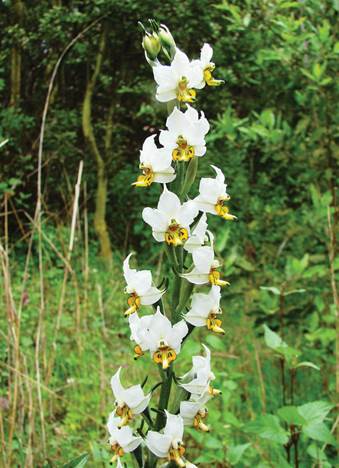
Photograph by Patricio Novoa.
Figure 23 Asarca spectabilis Phil. as Gavilea venosa (Lam.) Garay & Ormerod.
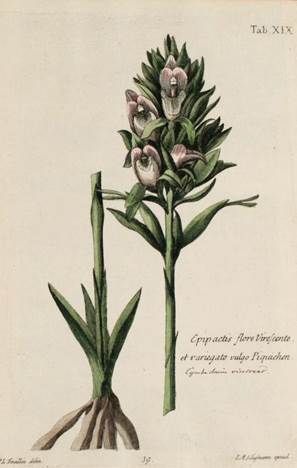
Figure 24 Epipactis flore virescente et variegatum vulgo Piquichen. Type specimen for the genus Chloraea = Chloraea piquichen. In Feuillée, 1756: plate XIX.
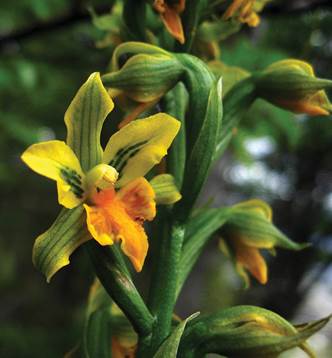
Photograph by “pabloendémico”.
Figure 32 Chloraea litoralis Phil. as Gavilea littoralis (Phil.) M.N.Correa.
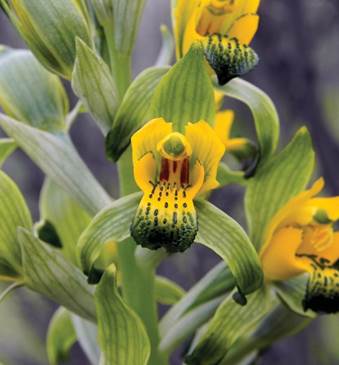
Photograph by Patricio Novoa.
Figure 33 Chloraea papillosa Phil. as Correorchis cylindrostachya (Poepp.) Szlach. Collected by P. Germain.












 uBio
uBio 
